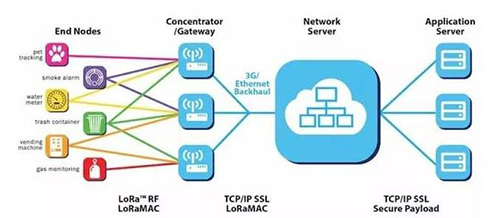

— Blogs —
—Products—
 Consumer hotline +8618073152920
Consumer hotline +8618073152920 WhatsApp:+8615367865107
Address:Room 102, District D, Houhu Industrial Park, Yuelu District, Changsha City, Hunan Province, China
Product knowledge
Time:2021-12-29 21:53:05 Popularity:1921
Wireless communication technology: the principle of spread spectrum LoRa frequency hopping spread spectrum communication (FHSS)
Spread Spectrum Communication, that is, spread spectrum communication technology (Spread Spectrum Communication), its basic characteristic is that the bandwidth of the signal used to transmit information is much larger than the bandwidth of the information itself.
Increasing the signal bandwidth can reduce the requirement for the signal-to-noise ratio. When the bandwidth is increased to a certain level, the signal-to-noise ratio is allowed to be further reduced. Spread spectrum communication is the use of broadband transmission technology in exchange for the benefits of signal-to-noise ratio, which is the basic idea and theoretical basis of spread spectrum communication.

Why wireless communication technology uses spread spectrum technology:
1. Expand bandwidth and reduce interference
When the spreading factor is 1, data 1 is represented by "1", and when the spreading factor is 4, "1011" may be used to represent 1, so that the bit error rate, that is, the signal-to-noise ratio, can be reduced during transmission, but However, the actual data that can be transmitted is reduced. Therefore, the larger the spreading factor, the smaller the number of data transmitted.
2. According to the different requirements of the rate, different numbers of code channels are allocated to improve the utilization rate
The spreading factor has another purpose, that is, the orthogonal code (OVSF: Orthogonal Variable Spreading Factor, orthogonal variable spreading factor). The orthogonal spreading code can be obtained through OVSF. When the spreading factor is 4, there are 4 Two orthogonal spreading codes, the orthogonal spreading codes can make the wireless signals transmitted at the same time not interfere with each other, that is, when the spreading factor is 4, the information of 4 individuals can be transmitted at the same time. The data rate requirements of voice and data services are different, so their spreading factors are different.
FHSS, Frequency-Hopping Spread Spectrum technology (Frequency-Hopping Spread Spectrum) is synchronized and at the same time, accepts both ends to transmit signals with a specific type of narrow-band carrier. For a non-specific receiver, FHSS generates hopping The signal is only impulse noise to it.
When a single data packet time may exceed the maximum channel dwell time allowed by relevant laws and regulations, FHSS technology will be used. Turning on the frequency hopping mode in LoRa is to operate RegHopPeriod and FreqHoppingPeriod registers to non-zero values.
The principle of LoRa for frequency hopping spread spectrum communication (FHSS):
The working principle of the FHSS frequency hopping spread spectrum scheme is: part of the content of each LoRa data packet is transmitted through the frequency hopping channel set by the MCU management, and the frequency to be "hopped" (according to the frequency lookup table) is sent out in the predetermined frequency hopping cycle After the end, the transmitter and receiver will switch to the next channel in the pre-defined frequency hopping list to continue sending and receiving the next part of the data packet.
The residence time in any channel is determined by FreqHoppingPeriod, and the value is an integer multiple of the symbol length.
The process of sending and receiving through frequency hopping starts from channel 0. . So the preamble and header part will be sent on channel 0 first. Every time you start to send a data packet, the reading of the channel counter FhssPresentChannel (located in RegHopChannel) will increase, and an interrupt signal FhssChangeChannel will be generated to achieve frequency hopping.
A new frequency must be set within the frequency hopping period to ensure that the new frequency will be covered when the frequency is hopped next time.
FHSS reception usually starts from channel 0. After checking the preamble, the receiver will start the above frequency hopping process. At this time, if the CRC of the Header is incorrect, the receiver will automatically request channel 0 (data packet retransmission mechanism), and Restart the Check preamble.
Related recommendations
Sensors & Weather Stations Catalog
Agriculture Sensors and Weather Stations Catalog-NiuBoL.pdf
Weather Stations Catalog-NiuBoL.pdf
Related products
 Combined air temperature and relative humidity sensor
Combined air temperature and relative humidity sensor Soil Moisture Temperature sensor for irrigation
Soil Moisture Temperature sensor for irrigation Soil pH sensor RS485 soil Testing instrument soil ph meter for agriculture
Soil pH sensor RS485 soil Testing instrument soil ph meter for agriculture Wind Speed sensor Output Modbus/RS485/Analog/0-5V/4-20mA
Wind Speed sensor Output Modbus/RS485/Analog/0-5V/4-20mA Tipping bucket rain gauge for weather monitoring auto rainfall sensor RS485/Outdoor/stainless steel
Tipping bucket rain gauge for weather monitoring auto rainfall sensor RS485/Outdoor/stainless steel Pyranometer Solar Radiation Sensor 4-20mA/RS485
Pyranometer Solar Radiation Sensor 4-20mA/RS485
Screenshot, WhatsApp to identify the QR code
WhatsApp number:+8615367865107
(Click on WhatsApp to copy and add friends)
